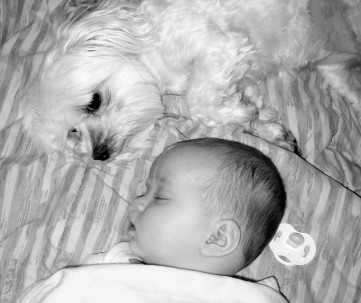Should you let your child sleep on their backs once they start rolling?
This is a good question that came up on a mom’s forum.
Since 1992, the American Academy of Pediatrics(AAP) has been advocating, “Back to Sleep” and has effectively decreased the incidence of Sudden Infant Death Syndrome (SIDS) by 50%. With “Back to Sleep”, all mothers were advised to stop putting their infants to sleep on their sides or tummy’s and put them to sleep on their backs.
This is an easy task until your baby starts rolling which developmentally occurs around 6 months of age (but as early as 4 months). Once they start rolling, what is a mother to do? Especially since an infant may not master rolling back onto their backs for a short while. Meaning they will get “stuck” on their tummy’s from time to time. With fear instilled in us, do we lay vigilant next to our infants and roll them back over all night?
BabyCenter’s SIDS Expert Dr. Fern Hauk says:
“Once a baby is strong enough to roll onto his stomach by himself, you don’t need to worry about him staying on his back all night. This is especially true if he’s been enjoying playtime on his tummy during the day, can hold his head up well, and can roll from his tummy onto his back again by himself.”
Her statement is not entirely clear whether parents should be vigilant to turn their infants if they are not rolling both ways. But I would have to say; it is not realistic to do so! 90% of SIDS cases occur under 6 months of age. By the time an infant is rolling, they have a lower chance of developing SIDS.
Furthermore, Infants will usually cry out if they get stuck. I remember those days of being awaken repeatedly when this happened. It feels like an eternity but the time goes quickly until your infant learns to roll both ways. Once they are rolling, it is wise to stop swaddling your infant if you are, as he will need his arms to help him roll back over. Additionally ensure your infant is getting “tummy time” daily.
While we are on the subject, I thought it would be a good time to review the things that have been found to decrease, increase, and make no difference in regard to the risk of SIDS
Associated with a decrease risk of SIDS:
- Cooler room temperatures (fan use in one study)
- Firm surfaces
- Freely circulating air
- Immunizing your infant (may decrease)
- Breastfeeding
- Pacifiers (in 7 studies)
- Room sharing with a parent without co-sleeping
Associated with increased risk of SIDS:
- Overheating (2 or more layers of clothing on an infant in 1 study)
- Exposure to tobacco smoke as well as maternal smoking during pregnancy
- Prone sleeping (on their tummies)
- Soft Surfaces along with use of blankets, loose bedding and bumper pads
- Co-sleeping (Controversial and inconsistent results in studies. But there appears to be an association in infants less than 4 months of age or if the mother smokes. Because of this the AAP recommends against co-sleeping)
Makes no difference in regard to risk of SIDS:
- Positioning tools to keep your infant on their backs (Some reports of children suffocating as a result of their use)
- Cardio-respiratory monitors
With all these risk factors what is a mother to do aside from putting her infant to sleep on their tummy? Make sure the room is cool, and that air can circulate freely around your infant’s nose. This would include avoiding bassinets with covers over your infant’s head, bumper pads, blankets and sheets. Implement as many of the protective factors as you can.
The choice to use a pacifier is individual to each mother. But every mother should be aware of this association with decreased risk and maker their own decisions. This also goes for co-sleeping. There are many parents who successfully co-sleep with their infants. For more information look about safe co-sleeping, you can look here.
It was difficult to find a photo of an infant sleeping on their backs. Most infants photographed sleeping are placed on their tummy for the photo! Please note the blanket under the infant in the photo is not taut as it should be. This was my daughter at 4 months of age with a friends dog that was “protecting” her.























